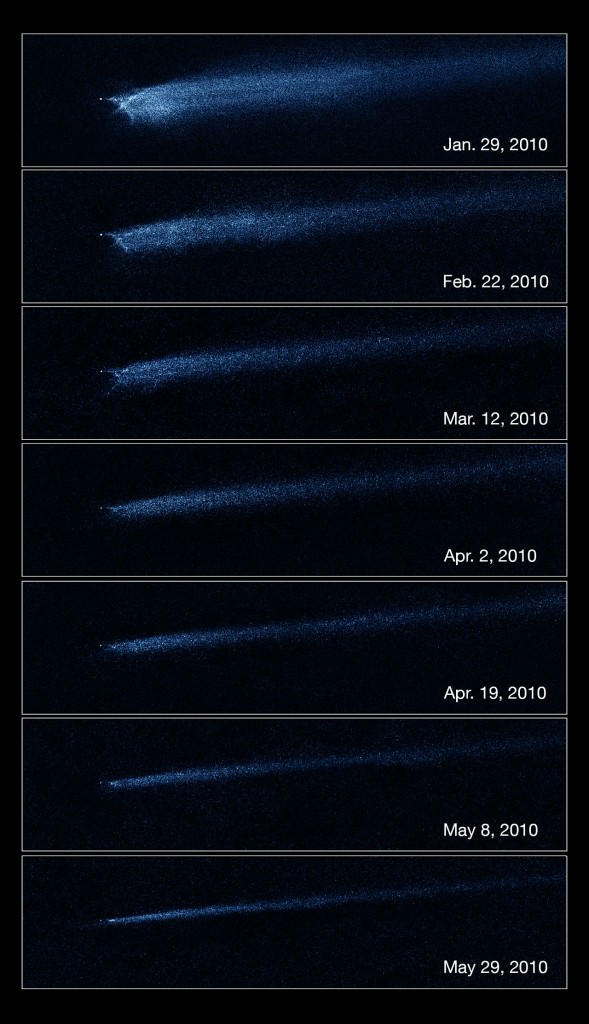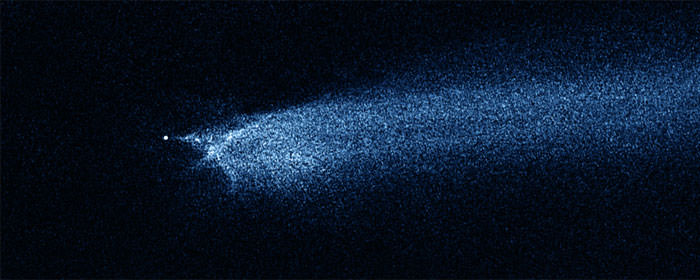[/caption]
Alas, the image above is not marking alien pirate treasure in space – for the first time, the aftermath of a collision between two asteroids has been imaged. Last January, an international team of astronomers saw the strange X-shaped object with the Hubble Space Telescope after ground-based observatories spotted evidence of an asteroid collision in the asteroid belt. The team has now used Hubble to do follow-up observations and uncovered a few surprises about the collision.
The collision produced an X shape, followed by a long comet-like tail. The astronomers, led by David Jewitt of the University of California in Los Angeles, were surprised to find that the collision did not happen as recently as they’d thought, but had actually occurred almost a year previous to the detection. It’s likely that the two asteroids smashed together sometime in February or March of 2009.
“When I saw the Hubbble image I knew it was something special,” said ESA astronomer Jessica Agarwal in a press release.
Named P/2010 A2, the object is located in the asteroid belt between Mars and Jupiter. Asteroid collisions are thought to be a commonplace occurrence, and are responsible for kicking up dust in our Solar System and other planetary systems. Just how much dust is produced, and how frequent the collisions happen is still a hazy topic, and the recent observation of P/2010 A2 should help astronomers to better model this phenomenon.
By figuring out how much dust is produced by the process of ‘collisional grinding’, astronomers could better model the dusty debris disks of other planetary systems, as well as our own.
The team monitored the slow-motion expansion of the leftovers of the colliding asteroids with the Hubble Space Telescope between January and May of 2010. They’ve determined that P/2010 A2 is about 120 meters (393 feet) wide, and the particles of dust that make up the tail following it are between 1 millimeter (0.04 inches) to 2.5 centimeters (1 inch) in diameter.
The remnants of the collision suggest that a smaller asteroid – 3 to 5 meters (10-16 feet) wide – collided into a larger one at about 18,000 km per hour (11,000 miles per hour). This vaporized the smaller asteroid, and ejected material from the larger one.
Why is the object X-shaped? That mystery has yet to be determined. It is likely, according to the team, that the filaments produced by the collision suggest asymmetries in the colliding objects. Further observations of P/2010 A2 with the Hubble in 2011 will show just how the collision continues to change, allowing for a more precise model of how it started out.
The observed tail is caused by the same mechanism that produces cometary tails – radiation pressure from the Sun pushes the dust away from the nucleus of the object.
As to why we don’t have thousands of Hubble images to produce a whole alphabet of asteroid collisions shapes – “Catching colliding asteroids on camera is difficult because large impacts are rare, while small ones, such as the one that produced P/2010 A2, are exceedingly faint,” Jewitt said. The results of their observations will be published in the October 14th issue of the journal Nature.
Source: ESA Press Release


There’s a typo in the third paragraph: Hubble is misspelled as “Hubbble”. 😉
There’s number in your name between N and M. Correct it.
For your information, my name is written that way on purpose: “3MAN” as in “I am not a number, I am a Free Man!” 😉
Be so cool to see Comet Hartley 2 get smacked by an asteroid!? or how about an asteroid THEN a big CME?
I’ve Been watching as C. Hartley passed the Double Cluster in Perseus with a simple 4.5″ reflector. Now its down toward Camelopardalis headed toward the dawn sky, rising later and later. A Cloud like apparition and just barely bright enough to see nakid eye from a dark site, it IS easily observable in binoculars or small telescope if you know where to look.
What a HOOT! This is Comet number 44 for me!
Prosit! ~@; )
We’ve been on 2 you – we got your #. I, for 1, hail our Spelling Overlords. (Except that I had to switch from comment notification to manual read and sort. Itz a bower iff therez onli speling corections too reed. Wee nedz inteligunt coment skrening off none-inteligunt comentz. :-/)
We missed the collision because we are lacking a telescope system that would observe the entire solar system at all times. Wide field cameras on both solar poles and Earth orbit Lagrange point observatories.
Telescopes at solar pole’s need to provide an early detection capability for the others, having a the whole earth orbit covered would provide tracking.
Additional coverage from L3 would be a start. 🙂
“I’m on the run, I kill to eat.
I’m starving now, I’m feeling dead on my feet.
Going all the way, I’m nature’s beast.
Do what I want, I’ll do as I please.”
And HEADAROUNDYOU you are an ass…
Would something like this be visible to the naked eye? After reading an article about this quite a while back I realised that it looked remarkably similar to something I witnessed while gazing around the time of year it occured.
“We missed the collision because we are lacking a telescope system that would observe the entire solar system at all times.”
Also noted in the press release: “[David] Jewitt is confident that future telescopes will find plenty of asteroid encounters. He expects the planned Large Synoptic Survey Telescope (LSST) to spot dozens of asteroid collisions shortly after they happen”. When added with Northern Hemisphere data from PanSTARRS we should get our first observation-based statistics for events like this. And, now we have a better idea on what to look for.
Large Synoptic Survey Telescope (LSST) is a good step towards this, but it remains earthbound. To get the full picture we need to put telescopes like this in space, on the solar poles would be awesome.